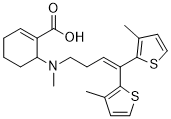This product is for research use only, not for human use. We do not sell to patients.

| Size | Price |
|---|---|
| 250mg | Get quote |
| 500mg | Get quote |
| 1g | Get quote |
Cat #: V5507 CAS #: 1426208-69-6 Purity ≥ 99%
Description: RPC425, a conformationally restricted analogues of γ-aminobutyric acid (GABA), is a novel, potent and noncompetitive Inhibitors of the Betaine/γ-Aminobutyric Acid Transporter 1 (BGT1). GT1 has emerged as an interesting target for treating epilepsy due to animal studies that reported anticonvulsant effects for the GAT1/BGT1 selective inhibitor EF1502 and the BGT1 selective inhibitor RPC-425.
Publications Citing InvivoChem Products
Product Promise

- Physicochemical and Storage Information
- Protocol
- Related Biological Data
- Stock Solution Preparation
- Quality Control Documentation
| Molecular Formula | C22H27NO2S2 |
|---|---|
| CAS No. | 1426208-69-6 |
| SMILES Code | O=C(C1=CCCCC1N(C)CC/C=C(C2=C(C)C=CS2)/C3=C(C)C=CS3)O |
| Synonyms | RPC425; RPC-425 |
This equation is commonly abbreviated as: C1 V1 = C2 V2
- (1) Please be sure that the solution is clear before the addition of next solvent. Dissolution methods like vortex, ultrasound or warming and heat may be used to aid dissolving.
- (2) Be sure to add the solvent(s) in order.




































